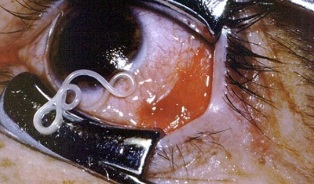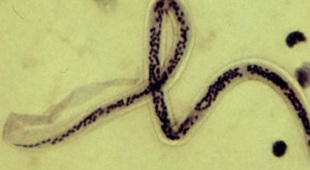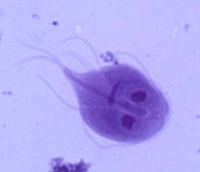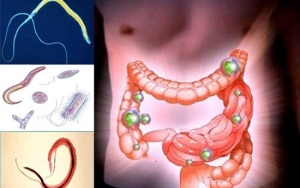
Parasites in biology are considered to be those creatures that perform life activities at the expense of another creature of another species.
This vital activity of parasites will not bring any benefit to the host organism, and at best will not lead to the development of negative effects.
In the worst case, the parasite will kill the host. In this case, either the parasite escapes to the external environment, or they die together.
Since the primitive age of human existence, people have known about human parasitic diseases. This fact is established in the process of observing the behavior of human direct ancestors. The monkey found the parasites living in the wool and eliminated them from each other. This process has very important characteristics of social interaction.
Back to homepage Human intolerance to the appearance of pimples and holes on the skin can also be traced back to the early days of human survival. Certain insect parasites in tropical regions can place larvae on the skin. This leads to a reflex impulse that squeezes it out of the skin.
Ancient scientists described various worms that affected the eyes, skin, and gastrointestinal tract. In the 18th to 19th centuries, with the development of microscopy technology and its introduction into medical practice, scientists determined the causes and routes of the spread of parasites that may cause specific human diseases.
- In the early 20th century, the discovery of antiparasitic drugs enabled humans to deal with most parasitic diseases.
Therefore, humans have coexisted closely with various parasites almost throughout history. However, modern medical science makes it possible to diagnose all parasites quickly and accurately, which gives doctors the opportunity to treat such diseases in the shortest time and with minimal risk to patients.
A general practitioner will help you determine the parasites, symptoms and treatments in the human body. Sometimes, infectious disease specialists with smaller specialties-parasitologists-can participate.
What is a parasitic disease?

Parasitic diseases are diseases that occur after biological agents are introduced (invaded) into the body. The latter are called human parasites. The symptoms of such diseases are extremely diverse and depend entirely on the substances that have penetrated and carried out life activities in the body.
According to the way parasites affect the human body, they are usually divided into the following categories:
- Parasites that affect human skin and hair.
- The toxic effects of parasite waste products on the human body.
- Parasite damage to the gastrointestinal tract and lung mucosa.
- The formation of cysts and cysts in human organs. Such cysts and increased size of cysts cause specific symptoms of organ compression.
- disrupts the normal passage of food through the gastrointestinal tract. This can lead to the development of intussusception (more common in children) or intestinal obstruction.
- Parasites living in the human body can cause allergic reactions and non-specific allergic reactions.
- Microparasites can destroy the function of blood cells, causing fever and poisoning.
- The effects of certain types of parasites on the body can cause not only severe symptoms, but also organ failure or death.
Human parasites

The main way humans infect parasites depends on the life cycle of biological organisms, and organisms are the pathogens of parasitic diseases.
The way doctors determine that the parasite has penetrated people is as follows:
- Contact path.It is a characteristic of ectoparasites and some worms that mainly live in water. The larvae of these worms penetrate human skin. You can get the infection either from the sick or through contaminated linen, bedding, personal or public health items.
- Stool-oral routeinfection. It occurs when the pathogen's cysts enter food after contact with infected feces (mainly from animals). Self-invasion can also be observed-if personal hygiene is not observed, it is a person's own infection, etc.
- Pollution.When crushing an infected insect, the pathogen enters the blood.
- Spread the infection.Parasites enter the bloodstream after being bitten by diseased insects. In most cases, this route of transmission is characteristic of the simplest parasites (such as malaria).
- Sexually transmitted infections.This is a typical situation for STDs caused by parasites and certain worms that may affect human urinary and reproductive tracts.
Protozoa, worms (roundworms and flatworms), insects and certain types of fungi are all attributed to parasitic diseases.
The occurrence of humans with these species depends on geographic and climatic regions. Therefore, each country’s medicines have their own records and lists of parasites with their own characteristics.
Medical biologists and doctors have conducted detailed studies on the organisms that enter the human body, which makes it possible to clearly classify all biological species that may cause parasitic diseases:
- The simplest organisms (spandex, rod-shaped disease, bainite disease, Chagas disease, leishmaniasis, malaria, giardiasis, trypanosomiasis, toxoplasmosis, trichomoniasis).
- Worms. The term helminths is sometimes used (a worm disease, onchocerciasis, bilobular flagellosis, rash, bronchiectasis, aspenworm disease, strongyloidiasis, tenosynovitis, fasciitis, schistosomiasis, intestinal biasisDisease, echinococcosis).
- External parasites (lice (yin, head, clothes), demodicosis, fleas, bugs, scabies).
Signs of parasites in the human body

Unfortunately, there are no definite signs of parasites in the human body, nor any signs of one or another parasite infection. This leads to the fact that in order to make an accurate diagnosis (such as helminthiasis), a specific examination is required.
On the other hand, almost all foreign infections can be diagnosed very simply-based on clinical manifestations and the presence of certain insects on the skin.
Generally speaking, all symptoms of parasitic diseases can be divided into the following categories:
- Skin itching and discomfort caused by external hair and skin parasites (fleas, lice, and others). Acne-like and itchy rashes are usually associated with demodicosis (a special kind of tick).
- Pain in various parts of the body caused by parasites entering the skin and muscles (some types of worms live in water).
- Eye pain and blurred vision.
- Lung pain, coughing sputum (this situation is typical for the migration of scar larvae and echinococcus in the lungs).
- Nausea, vomiting, and diarrhea are very common symptoms of most worms that live in the digestive tract.
- Jaundice, hepatobiliary disease, liver failure. These symptoms occur with worms that affect the liver and biliary tract and malaria at the peak of the disease.
- Stomach pain.
- Intestinal obstruction caused by the closure of the intestinal cavity, in which there are a large number of roundworms or flatworms.
In the absence of other pathological data, all these symptoms of parasites in the human body should prompt doctors to consider parasitic human diseases and serve as the basis for diagnosis and laboratory research.
Diagnosis of human parasites
According to the type of parasites that invade the human body, one or another study was conducted. If we are mainly talking about external parasites of insects, then the diagnosis of the disease is usually limited to general examination and insect microscopic examination.
General examinations can usually provide accurate diagnosis and proper treatment or disinfection of the scalp or skin. In the case of demodicosis or scabies, the diagnosis can be easily established based on the location of the rash and the presence of itching.
In this case, the microscopic examination of the scratches confirmed the diagnosis of intradermal parasites.
For gastrointestinal parasites, the main screening study (a diagnostic procedure that allows you to quickly and relatively beneficially assess the presence of the disease in many people) is stool analysis.
- Through a special stool microscope examination, the laboratory assistant can assess the presence of worm eggs, dead insects, cysts, etc.
Through the shape of the worm eggs, you can almost accurately determine the type of worm that is parasitic in the body. Sometimes in the feces, the tapeworm fragments are determined macroscopically. They are then examined under a microscope to determine the appearance of flatworms that are parasitic in the gastrointestinal tract.
For example, in some cases, if fecal analysis cannot be used to diagnose parasites in the body, or if sufficient information is not available, immunological research can be used. They allow you to assess the presence of antibodies against specific types of worms. Unfortunately, due to the special immunological relationship between the human immune system and parasites, in some cases the level of antibodies may not reflect the true state of the disease.
For malaria, a drop of blood is needed to detect the parasite. In addition, general blood counts, white blood cell levels and all biochemical parameters of the blood, especially the liver, are also evaluated.
Elevated levels of eosinophils in the blood are not only a common symptom of allergic diseases, but also a common symptom of worm invasion. This is the first "bell".
Sometimes, during angiography, cystoscopy, FGDS, colonoscopy, worms in the gastrointestinal tract are diagnostic findings.
How to eliminate parasites in the human body?

The treatment of parasitic infections should only be performed by a doctor in accordance with certain rules.
In this case, self-medication and traditional medicine will not bring improvement, and sometimes it can be fatal.
It is also important to provide preventive treatment for all family members and contacts.
The human ectoparasites that parasitize the human hair area are destroyed by special disinfectants. Usually, sanitary cleaning after a single treatment is sufficient to kill the parasites.
When it comes to skin type parasites (sc sores, helminthiasis), please use special ointments containing insecticides to fight against such organisms.
Anti-helminths can be used to fight round worms and flatworms. They act especially on worms in the main cavity of the gastrointestinal tract. Depending on the biological type of the worm, various treatment options (from a pill to a series of treatments) can be used.
Such drugs should be used strictly under the guidance of a physician in order to identify the adverse effects and side effects of the drugs in time.
There are no other treatments, detox procedures, etc. that can cause the internal parasites to die completely and thus cure a person.



























